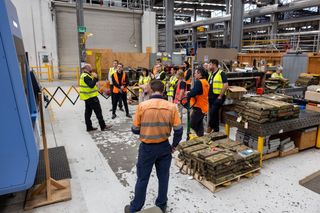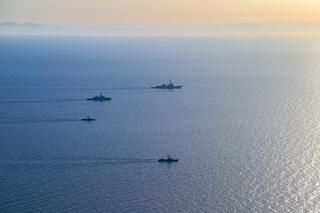Recent efforts by Australia, Britain and the United States to harmonise their defence trade controls are welcome, if long overdue.
But there are reasons to worry that AUKUS Pillar II may be carved out of the very regulatory framework intended to facilitate it. This is a problem if the development of advanced capabilities is to be a truly collaborative effort.
Indeed, If AUKUS technologies cannot be insulated against long-standing issues associated with the reach of US defence export controls, Australian and British companies will continue to encounter longstanding disincentives to participating in advanced capability projects with the United States.
Granted, Australia would certainly benefit from these harmonisation efforts. The sum of the three countries’ respective export control reforms would see approximately 70 per cent of defence trade made eligible for license-free movement between the three countries, fast-tracking everyday defence industrial cooperation between verified entities in Australia, Britain and the United States.
It has been a longstanding Australian objective to accelerate defence industrial integration with the United States. In that sense, these AUKUS-inspired reforms may yet succeed where previous efforts failed.
But, worryingly, the potential benefits for AUKUS technology collaboration are currently far less clear. This is due to two interrelated factors.
Firstly, AUKUS defence trade control harmonisation efforts should not be mistaken for fundamental reforms to the US International Traffic in Arms Regulations (ITAR).
This is an essential distinction, given that the creation of an AUKUS platinum standard for export controls is premised on the comparability of Australian and the British defence trade controls to America’s own defence trade control regulations, including the ITAR. The explanatory memorandum accompanying Australia’s recently passed Defence Trade Control Amendment Bill makes that much clear.
Though the harmonisation efforts include licensing exemptions for each country from one another’s regulations, these are not blanket in coverage. This is crucial with respect to the ITAR, for what has been proposed in Washington are limited licensing exemptions for certified AUKUS entities, not fundamental reforms to many of the ITAR’s well-known flaws.
This means that those items not covered by the AUKUS exemption involving substantive US input will remain subject to the ITAR’s more problematic aspects, including extraterritorial jurisdiction and broad definitions of defence ‘articles’ or ‘services’. Particularly problematic is the so-called taint, arising from the use of American defence articles or services in joint capability development projects which requires operators or owners to acquire licenses from the State Department for defence articles made with certain US parts or knowledge, even when the final products are predominantly allied-made.
As detailed by former US ambassadors and charges d’affaires to Australia, the ITAR taint has historically created months of delays to routine repair work on US air force and naval assets in Australia, including by preventing easy transfer of even the most mundane of defence materials like bolts and screws.
But as William Greenwalt, former US undersecretary of defense for industry, and I wrote in our report on ITAR reform last year, the taint has also frequently seen US-origin defence material and services designed out of allies’ capabilities and supply chains. It has also prevented Australian companies from delivering made-to-order product variants for US war fighters, because they’ve wanted to avoid risk of US regulatory capture due to the inclusion of what could be interpreted as US intellectual property.
This leads to the second factor: the scope of the excluded technologies list (ETL), a list of items and services ineligible for the so-called AUKUS exemption.
Comprising the 30 per cent of intra-AUKUS defence trade not captured by the licensing exemption, the ETL is based on a combination of the three countries’ commitments to international non-proliferation regimes, particularly the Missile Technology Control Regime (MTCR; 25 percent), as well as national-level policy decisions not to make these technologies more freely available to AUKUS partners for legal or political reasons (5 per cent).
Many of these technologies will be essential to the development of advanced capabilities through AUKUS Pillar II. In fact, officials have presented the ETL as explicitly intended to capture Pillar II technologies, citing the need to safeguard shared capability advantages, though they have also stressed that these technologies remain attainable with an appropriate export license.
This is understandable, but still problematic. Put simply, the ETL in its current format could amount to the exclusion of AUKUS technologies from the AUKUS country exemption. This means that these technologies would remain subject to standard defence trade licensing requirements in all three countries — including the ITAR.
And that would mean that the well-known issues with US export controls would continue to apply to the very technologies which these regulatory harmonisation efforts were intended to minimise. The practical result would be that, even if more than 90 percent of componentry found in a future AUKUS advanced capability were eligible for a license waiver, the ITAR would still taint that capability if any of the remaining 10 percent of components were on the ETL and were US-made or featured notable US design input.
In the absence of structural reforms to the ITAR or further amendments to the contents of the ETL or the conditions for their transfer between users, the well-known problems associated with US defence trade controls would almost certainly continue to impede high-end defence technology cooperation. This is problematic if co-innovation and co-development leveraging the best technologies available from all three countries is a desirable end-state for AUKUS Pillar II.
To be clear, defence trade control harmonisation is absolutely required. I have argued previously that developing trilateral protections is as essential as developing trilateral capabilities.
But without immunising the ETL against the ITAR taint, AUKUS risks moving slower than the speed of strategic relevance. Consider, for example, that the three countries trail their chief competitors in several Pillar II categories, such as hypersonics. Encouragingly, government officials working on AUKUS see the ETL as a starting point, while industry is also alert to the need to amend the ETL to facilitate both pillars (Pillar I being focused on nuclear submarines). Doing so is no enviable task, and will not be straightforward. For instance, reinterpreting the three countries’ obligations under the MTCR with respect to discrete technologies would be a heavy political lift, considering the three governments’ commitments to the highest non-proliferation standards and enduring negative perceptions across Asia of AUKUS Pillar I as a proliferation risk.
But realising the potential, and the spirit, of AUKUS will require creative thinking and a willingness to countenance greater risk-taking across the three systems. That approach must include in technology sharing, lest regulatory harmonisation efforts produce an arrangement that is AUKUS by country, not by technology.









